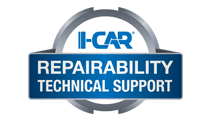
OEM Restraints System Part Replacement Search
2008 Pontiac G6 Sedan
DISABLE PROCEDURE AND TIME (Always Check Service Manual)
1. Turn the steering wheel so that the vehicle wheels are pointing straight ahead.2. Place the ignition in the OFF position.
3. Disconnect the negative battery cable from the battery.
4. Wait 1 minute before working on system.
PARTS THAT MUST BE REPLACED FOLLOWING A DEPLOYMENT
With Front Airbag Deployment:• Inflatable restraint instrument panel module [Instrument Panel Airbag], if deployed and after performing the necessary inspections listed
• Inflatable restraint steering wheel module [Steering Wheel Airbag], if deployed
• Inflatable restraint sensing and diagnostic module (SDM) [Airbag Control Module]
• Inflatable restraint front end sensor [Front Airbag Sensor], left/right
• Inflatable restraint seat belt pretensioners
• Replace any seat belt system that was in use during the collision serious enough to deploy any automatic restraint device such as air bags and seat belt pretensioners. This not only includes seat belt systems in use by people of adult size, but seat belt systems used to secure child restraints, infant carriers and booster seats, including LATCH system and top tether anchorages.
• Any damaged restraint system part
With Side Seat and Roof Airbag Deployment:
• Inflatable restraint side impact sensors (SIS) [Interior Airbag Sensor], on side of impact
• Inflatable restraint roof rail module [Roof Airbag], left/right, on side of impact, if deployed
• Inflatable restraint side impact module [Seat Airbag], on the side of impact, if deployed
• Inflatable restraint sensing and diagnostic module (SDM) [Airbag Control Module]
• Inflatable restraint seat belt pretensioners
• Seat belt system in use during a collision serious enough to deploy any automatic restraint device such as air bags and seat belt pretensioners. This not only includes seat belt systems in use by people of adult side, but seat belt systems used to secure child restraints, infant carriers and booster seats, including LATCH system and top tether anchorages.
• Any damaged restraint system part
Sensor Replacement Guidelines:
The front end sensor [Front Airbag Sensor] and SIS [Interior Airbag Sensor] replacement policy requires replacing sensors in the area of accident damage. The area of accident damage is defined as the portion of the vehicle which is crushed, bent, or damaged due to a collision.
• Replace the sensor whether or not the air bags have deployed.
• Replace the sensor even if it appears to be undamaged.
Sensor damage which is not visible, such as a slight bending of the mounting bracket or cuts in the wire insulation, can cause improper operation of the sensor. Do not try to determine whether the sensor is undamaged. Replace the sensor.
CAUTION: Restraint systems can be damaged in a collision. To help avoid injury and ensure that all parts in need of replacement are replaced:
Replace any seat belt system that was in use during a collision serious enough to deploy any automatic restraint device such as air bags and seat belt pretensioners. This not only includes seat belt systems in use by people of adult size, but seat belt systems used to secure child restraints, infant carriers and booster seats, including LATCH system and top tether anchorages.
Replace any seat belt system that has torn, worn, or damaged components. This not only includes adult seat belt systems, but built-in child restraints and LATCH system components, if any.
Replace any seat belt system if you observe the words "REPLACE" or "CAUTION", or if a yellow tag is visible. Do not replace a seat belt system if only the child seat caution label is visible.
Replace any seat belt system if you are doubtful about its condition. This not only includes adult seat belt systems, but built-in child restraints, LATCH system components, and any restraint system used to secure infant carriers, child restraints and booster seats.
Do NOT replace single seat belt system components in vehicles that have been in a collision as described above. Always replace the entire seat belt system with
the buckle, guide and retractor assembly, which includes the latch and webbing material.
After a minor collision where no automatic restraint device was deployed, seat belt system replacement may not be necessary, unless some of the parts are torn, worn, or otherwise damaged.
PARTS THAT MUST BE INSPECTED AND REPLACED IF DAMAGED
With Front Airbag Deployment:• Steering column
• Instrument panel knee bolsters and mounting points
• Instrument panel brackets, braces, etc.
• Seat belts not in use
• Seats and seat mounting points
• Passenger seat bottom with Passenger Presence System (PPS)
• Roof and headliner mounting points
• Inflatable restraint steering wheel module coil [Clock Spring] and coil wiring pigtail
• Mounting points or mounting hardware for the I/P, steering wheel module, SDM, and pretensioners
• Any part or wiring identified by diagnostic check
With Side Seat and Roof Airbag Deployment:
• Steering column
• Instrument panel knee bolsters and mounting points
• Instrument panel brackets, braces, etc.
• Seat belts not in use
• Seats and seat mounting points
• Passenger seat bottom with Passenger Presence System (PPS)
• Roof and headliner mounting points
• Mounting points or mounting hardware for the inflatable restraint SIS [Interior Airbag Sensor]
• Mounting points or mounting hardware for the roof rail module [Roof Airbag] (left/right) on the side of the impact
• Mounting points or mounting hardware for the inflatable restraint SDM [Airbag Control Module] and seat belt pretensioners [Front Seatbelt]
• Any part or wiring identified by diagnostic check
